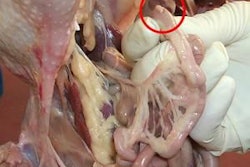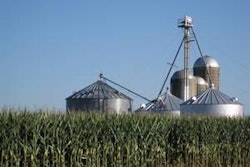
Meat demand has risen more dramatically across Asia than any other region over the last 20 years. Despite poultry being Asia’s fastest growing meat sector, pork is still the number one meat in countries such as China, Vietnam, the Philippines, and South Korea. As a mainstay of local cuisine and a familiar meat, pork consumption can be expected to grow further with rising affluence.
From under 10kg per person in the early-1990s, annual consumption of pork has risen to as much as 40kg in China and Taiwan. Across Asia, production growth has been driven primarily by China as well as Vietnam, which more than doubled its output between 2000 and 2009. Over that period, China’s production volume rose by some 25%. Asia’s pork industry is domestic driven with very little export as production has been directed mainly towards meeting local consumption.
Table 1: Per capita consumption selected countries 2005-2010
With the exception of Japan and South Korea, imports by Asian countries are minute in relation to domestic pork supply. Pork imports typically account for almost half of domestic consumption in Japan and 33% in South Korea. Fresh pork is still very much in demand among Asians who frequent traditional markets where pork, freshly slaughtered and hung on metal hooks, is sold with minimal packaging or cold storage facilities. Nevertheless, the rise of supermarket chains is shaping consumer demands for food safety and the evolution of the pork supply value chain.
Current profile
Any discussion of Asia’s pork sector will inevitably be dominated by the Chinese market. As the world’s biggest pork consumer in absolute tonnage, China’s pork industry is also the world’s most-watched. Production has been increasing steadily to keep up with demand; by 2015, projected pork demand is estimated at 68 million tonnes, an increase of 45% from 2009 levels or 6.5% in compounded annualized growth. Although the share of pork in China’s livestock production profile has been declining, pork continues to be the most popular meat at about 70% of total meat consumption, roughly the same level as in Vietnam.
Table 2: Pork productions for selected Asian countries 2000-2009
China is home to half the world’s total pig population, or 500 million head. As is the case with much of developing Asia, pig farming in China is very much a backyard family-run affair at 5-10 hogs per household. Despite moves towards a more consolidated production structure, about three-quarters of domestic pork production in 2008 still originated from small backyard operations or bigger rural hog production households with about 30 pigs. In comparison, commercial farms accounted for only 2% of production in 2008.
Bred for success
While H1N1 devastated pork prices and demand in much of North America and Europe, the effect was almost negligible in Asia. Undersupplied in pork with current production levels inadequate for future needs, producers have looked to increase output; imports, although at low levels, have been growing steadily.
Demand for breed genetics in Asia has gone “absolutely crazy”, observes Tony Osborne of BritAsia Pig Genetics in the Philippines. “A lot of farms are looking to triple their output in the next two to three years. Some farms are looking at 500 to 1,000 sires and want to more than double this to about 2,500 by 2010.”
Genetics in breeding will play a major role in the growing Asian pig sector. South Korea, Japan and Vietnam are leaders in this field, notes Osborne, while other countries such as Thailand, the Philippines and Malaysia are beginning to appreciate the importance of genetics.
With this comes a more targeted approach towards breeding. “Producers are now asking: ‘What breeds do we need to attain this level of productivity?’ They are not only looking to know what makes a good sow, sire or hog breed, they now want this breeding technology to be passed to them.” This could narrow the gap with advanced producers in the EU in the next eight years, estimates Osborne.
As lean growth weight improves and feed conversion falls, pig numbers could well decline as fewer pigs are required to meet total slaughter weights. In a model to project herd populations, Professor James Simpson of the University of Florida predicted that China’s pig numbers would fall to 403 million in 2020 from 500 million currently, and slide further to 392 million by 2030. Even as Asia moves towards heavier carcass weights, lower maintenance costs per unit weight, shorter finishing periods and lower emissions per pig would contribute to higher efficiencies in the sector.
Integrate, regulate
Despite offering great potential in long-term growth prospects, Asia is still some 10-20 years behind Europe in farming techniques, genetics, breeding practices, biosecurity and animal health and welfare. Livestock geneticist Rex Walters notes that, while some Asian producers have made great progress in genetic efficiency through markers such as litter size, growth rate, lean growth and feed conversion, much more could still be done.
“Real genetic progress is possible in Asia as long as people are committed to using up-to-date genetic and breeding technology. Some Asian companies have the right philosophy while others are happy to drift, making small levels of progress without understanding that cost-benefit is the key. It is all about commitment and investment.”
Close to the heels of commitment and capital come training, management and people development. Drawing parallels with US production history and current standards in China, Michael Boddington of Boddington Consulting in Beijing points out that similar strategies could help move China from current levels of up to 16 piglets per sow per year to 20 and above, narrowing the genotype-phenotype gap.
“Before 1995, the US pig industry was not integrated. Integration started in the mid-to-late-1990's as co-ordination of members in the value chain created efficiencies, information sharing and benchmarking, which have become the industry’s best practices”.
Integration would also overcome the problem of feed costs rising faster than pork prices. The entry of foreign players such as US-based AgFeed in China, which runs one of the country’s largest commercial hog operations, has also introduced new methods of production and technologies, and raised standards in management and efficiency. This also helps strengthen the role of genetics in the pig sector as haphazard practices have resulted in genetic advantages being eroded after a few years, only to have to start all over again.
It is estimated that Asia is home is about half the world’s swine gene pool. The sheer diversity of breeds also makes the risk of loss exceptionally high. While commercial western breeds often exhibit favorable commercial characteristics, this reflects the research that has gone into such breeds, rather than the inherent quality of the breed alone. At the same time, some native breeds are able to adapt very well to low quality feed ingredients indigenous to Asia. Feeding the region may be the most urgent task for Asia right now, but preserving a rich swine genetic pool could well be its most enduring.

















